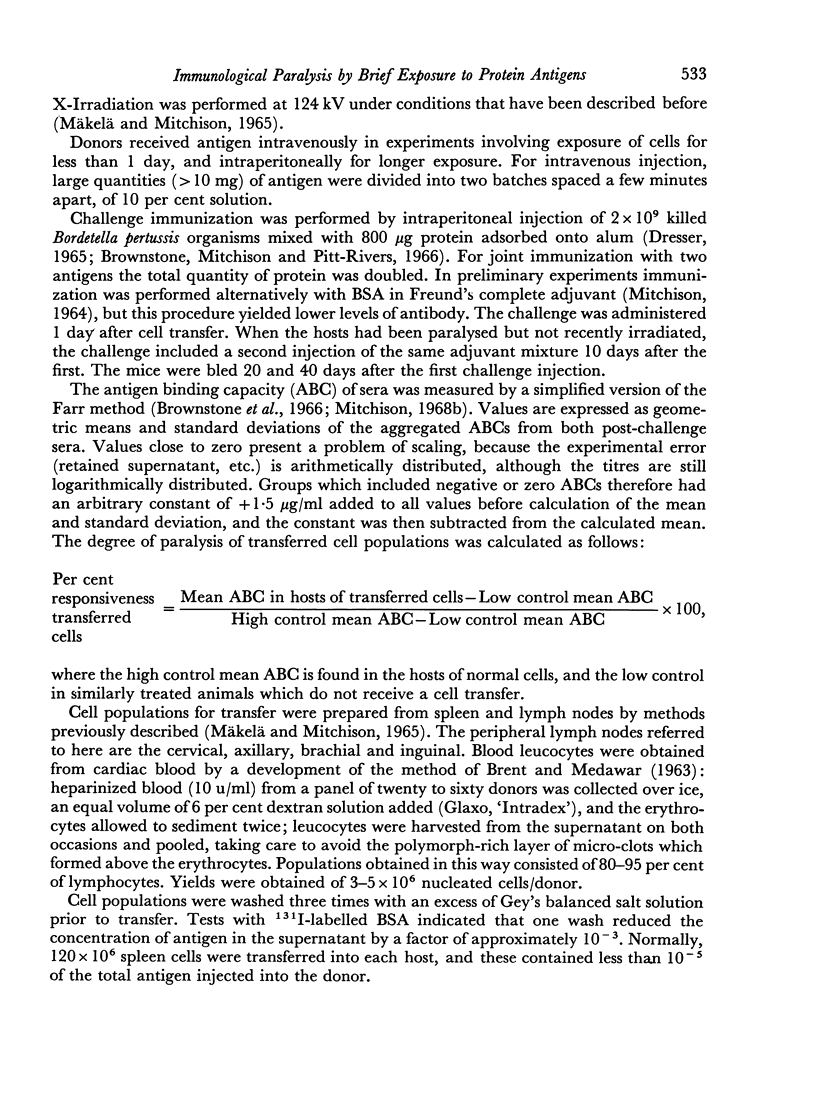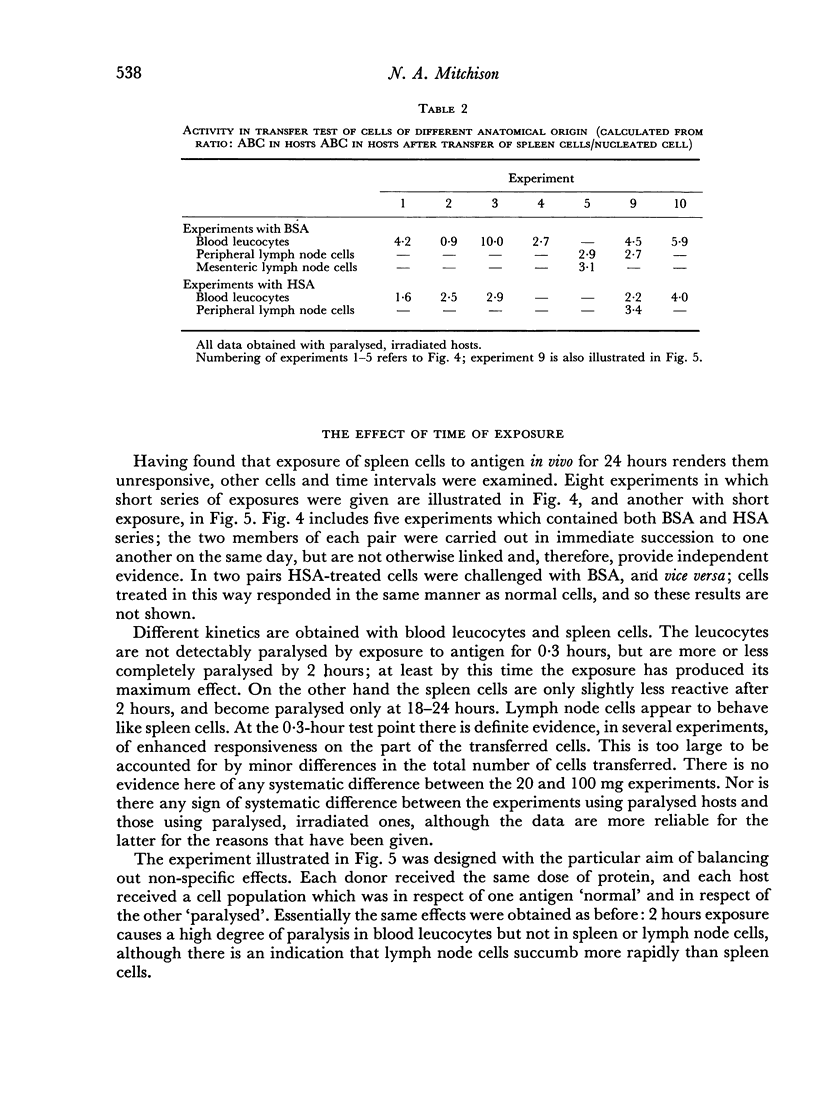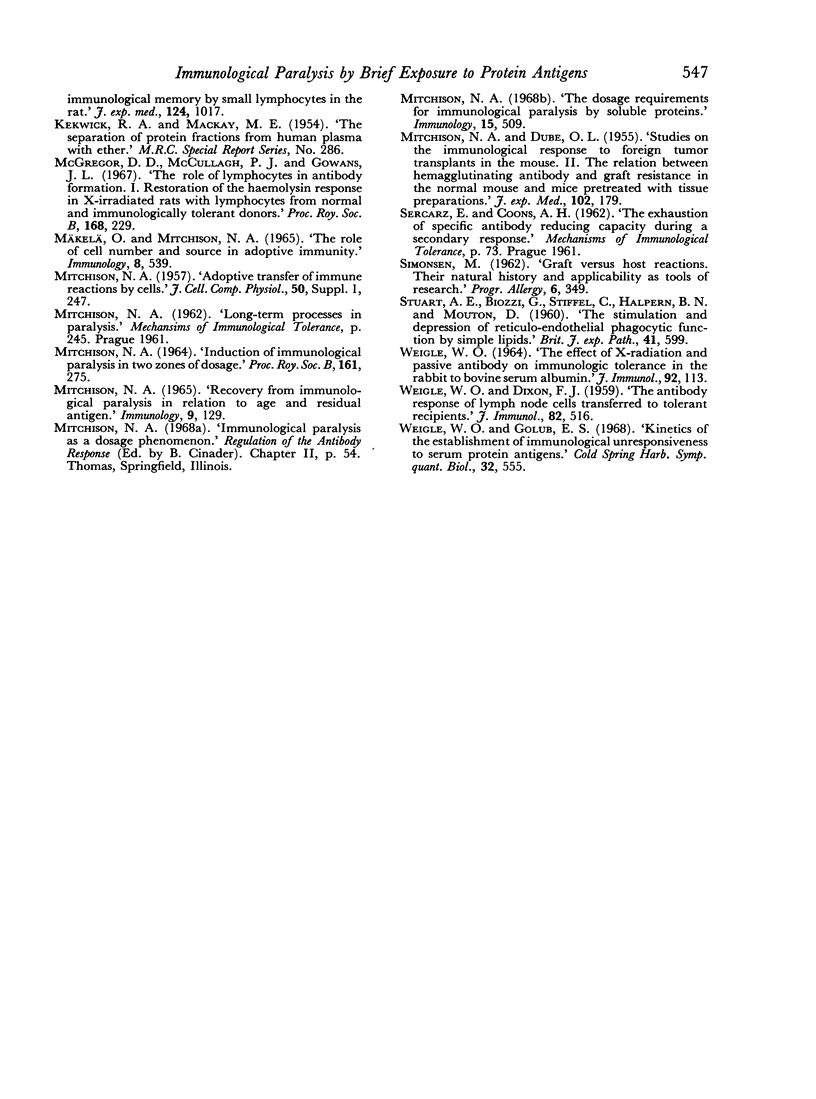Abstract
The paralysing effect of brief exposure to antigen has been studied in a system in which cells were exposed and then tested by challenge immunization after transfer into syngeneic unresponsive mice. Bovine and human serum albumins (BSA and HSA) were used chiefly, but lysozyme was also tested. Irradiation and paralysis on their own had drawbacks as methods of procuring unresponsive hosts, and worked best in combination. The response measured in the hosts as antigen binding capacity (ABC) was found to be proportional to the number of reactive cells transferred. Lymph node cells and blood leucocytes proved more active than spleen cells. Cells did not become paralysed immediately upon exposure to high concentrations of antigen; blood leucocytes required approximately 2 hours in vivo exposure, and cells from lymphoid organs approximately 24 hours. The effectiveness of 24 hours exposure depended on antigen dose. Tentative measurements of the time taken for antigen to diffuse through the organs suggested that this delay would not account for the difference in timing between cells of different anatomical origin. Exposure in vitro was not found repeatably effective in inducing paralysis. The conclusion was drawn that paralysis is induced by the direct action of antigen on lymphocytes, but that the cells may undergo some further step of differentiation before induction is complete.
Full text
PDF
















Selected References
These references are in PubMed. This may not be the complete list of references from this article.
- BENSON J. A., Jr, KIM K. S., BOLLMAN J. L. Extravascular diffusion of protein. Am J Physiol. 1955 Jul;182(1):217–220. doi: 10.1152/ajplegacy.1955.182.1.217. [DOI] [PubMed] [Google Scholar]
- BERGLUND K., FAGRAEUS A. A biological factor inhibiting the effect of cortisone on antibody formation. Nature. 1956 Feb 4;177(4501):233–234. doi: 10.1038/177233a0. [DOI] [PubMed] [Google Scholar]
- BILLINGHAM R. E., SILVERS W. K., WILSON D. B. FURTHER STUDIES ON ADOPTIVE TRANSFER OF SENSITIVITY TO SKIN HOMOGRAFTS. J Exp Med. 1963 Sep 1;118:397–420. doi: 10.1084/jem.118.3.397. [DOI] [PMC free article] [PubMed] [Google Scholar]
- BRENT L., MEDAWAR P. B. Tissue transplantation: a new approach to the "typing" problem. Br Med J. 1963 Aug 3;2(5352):269–272. doi: 10.1136/bmj.2.5352.269. [DOI] [PMC free article] [PubMed] [Google Scholar]
- Brent L., Medawar P. Quantitative studies on tissue transplantation immunity. 8. The effects of irradiation. Proc R Soc Lond B Biol Sci. 1966 Oct 11;165(1001):413–423. doi: 10.1098/rspb.1966.0074. [DOI] [PubMed] [Google Scholar]
- CLAMAN H. N., TALMAGE D. W. THYMECTOMY: PROLONGATION OF IMMUNOLOGICAL TOLERANCE IN THE ADULT MOUSE. Science. 1963 Sep 20;141(3586):1193–1194. doi: 10.1126/science.141.3586.1193. [DOI] [PubMed] [Google Scholar]
- DRESSER D. W. Specific inhibition of antibody production. I. Protein-over loading paralysis. Immunology. 1962 Jan;5:161–168. [PMC free article] [PubMed] [Google Scholar]
- DRESSER D. W. Specific inhibition of antibody production. II. Paralysis induced in adult mice by small quantities of protein antigen. Immunology. 1962 May;5:378–388. [PMC free article] [PubMed] [Google Scholar]
- Diener E., Armstrong W. D. Induction of antibody formation and tolerance in vitro to a purified protein antigen. Lancet. 1967 Dec 16;2(7529):1281–1285. doi: 10.1016/s0140-6736(67)90394-7. [DOI] [PubMed] [Google Scholar]
- Dresser D. W., Mitchison N. A. The mechanism of immunological paralysis. Adv Immunol. 1968;8:129–181. doi: 10.1016/s0065-2776(08)60466-6. [DOI] [PubMed] [Google Scholar]
- Dresser D. W. Specific inhibition of antibody production. IV. Standardization of the antigen-elimination test; immunological paralysis of mice previously immunized. Immunology. 1965 Sep;9(3):261–273. [PMC free article] [PubMed] [Google Scholar]
- FREI P. C., BENACERRAF B., THORBECKE G. J. PHAGOCYTOSIS OF THE ANTIGEN, A CRUCIAL STEP IN THE INDUCTION OF THE PRIMARY RESPONSE. Proc Natl Acad Sci U S A. 1965 Jan;53:20–23. doi: 10.1073/pnas.53.1.20. [DOI] [PMC free article] [PubMed] [Google Scholar]
- GESNER B. M., GOWANS J. L. The output of lymphocytes from the thoracic duct of unanaesthetized mice. Br J Exp Pathol. 1962 Aug;43:424–430. [PMC free article] [PubMed] [Google Scholar]
- GOWANS J. L., McGREGOR D. D., COWEN D. M. Initiation of immune responses by small lymphocytes. Nature. 1962 Nov 17;196:651–655. doi: 10.1038/196651a0. [DOI] [PubMed] [Google Scholar]
- Gowans J. L., Uhr J. W. The carriage of immunological memory by small lymphocytes in the rat. J Exp Med. 1966 Nov 1;124(5):1017–1030. doi: 10.1084/jem.124.5.1017. [DOI] [PMC free article] [PubMed] [Google Scholar]
- MITCHISON N. A. INDUCTION OF IMMUNOLOGICAL PARALYSIS IN TWO ZONES OF DOSAGE. Proc R Soc Lond B Biol Sci. 1964 Dec 15;161:275–292. doi: 10.1098/rspb.1964.0093. [DOI] [PubMed] [Google Scholar]
- MTTCHISON N. A., DUBE O. L. Studies on the immunological response to foreign tumor transplants in the mouse. II. The relation between hemagglutinating antibody and graft resistance in the normal mouse and mice pretreated with tissue preparations. J Exp Med. 1955 Aug 1;102(2):179–197. doi: 10.1084/jem.102.2.179. [DOI] [PMC free article] [PubMed] [Google Scholar]
- McGregor D. D., McCullagh P. J., Gowans J. L. The role of lymphocytes in antibody formation. I. Restoration of the haemolysin response in x-irradiated rats with lymphocytes from normal and immunologically tolerant donors. Proc R Soc Lond B Biol Sci. 1967 Sep 12;168(1012):229–243. doi: 10.1098/rspb.1967.0063. [DOI] [PubMed] [Google Scholar]
- Mitchison N. A. Recovery from immunological paralysis in relation to age and residual antigen. Immunology. 1965 Aug;9(2):129–138. [PMC free article] [PubMed] [Google Scholar]
- Mitchison N. A. The dosage requirements for immunological paralysis by soluble proteins. Immunology. 1968 Oct;15(4):509–530. [PMC free article] [PubMed] [Google Scholar]
- Mäkelä O., Mitchison N. A. The role of cell number and source in adoptive immunity. Immunology. 1965 Jun;8(6):539–548. [PMC free article] [PubMed] [Google Scholar]
- SIMONSEN M. Graft versus host reactions. Their natural history, and applicability as tools of research. Prog Allergy. 1962;6:349–467. [PubMed] [Google Scholar]
- WEIGLE W. O., DIXON F. J. The antibody response of lymph node cells transferred to tolerant recipients. J Immunol. 1959 Jun;82(6):516–519. [PubMed] [Google Scholar]
- WEIGLE W. O. THE EFFECT OF X-RADIATION AND PASSIVE ANTIBODY ON IMMUNOLOGIC TOLERANCE IN THE RABBIT TO BOVINE SERUM ALBUMIN. J Immunol. 1964 Jan;92:113–117. [PubMed] [Google Scholar]


